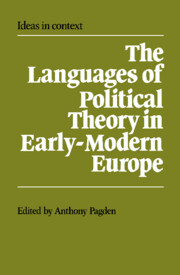Book contents
- Frontmatter
- Contents
- Notes on contributors
- Acknowledgements
- Introduction
- 1 The concept of a language and the métier d'historien: some considerations on practice
- PART I
- PART II
- 6 Sir Thomas More's Utopia and the language of Renaissance humanism
- 7 The concept of ordre and the language of classical republicanism in Jean-Jacques Rousseau
- 8 The language of seventeenth-century republicanism in the United Provinces: Dutch or European?
- 9 The civil religion of James Harrington
- PART III
- PART IV
- Index
- Ideas in Context
8 - The language of seventeenth-century republicanism in the United Provinces: Dutch or European?
Published online by Cambridge University Press: 04 September 2009
- Frontmatter
- Contents
- Notes on contributors
- Acknowledgements
- Introduction
- 1 The concept of a language and the métier d'historien: some considerations on practice
- PART I
- PART II
- 6 Sir Thomas More's Utopia and the language of Renaissance humanism
- 7 The concept of ordre and the language of classical republicanism in Jean-Jacques Rousseau
- 8 The language of seventeenth-century republicanism in the United Provinces: Dutch or European?
- 9 The civil religion of James Harrington
- PART III
- PART IV
- Index
- Ideas in Context
Summary
The Dutch Republic came into existence less as the result of a pre-conceived plan, than as a consequence of an unexpected combination of political events. As the Revolt spread and Spain responded with increasing use of force, the leading figures of the provinces of Holland and Zeeland found themselves compelled to consider (in general terms) the possibility of an independent state. But even after the States General had renounced Philip II in 1581 and declared their independence, it took a long time for these unsystematic ideas on sovereignty and the nature of the new state to be given any clear delineation. Political theory in the United Provinces continued to focus on the advantages and disadvantages of monarchy. A republican theory began to be formulated only with the greatest reluctance and it took until the second half of the seventeenth century before it came to be seen as a real alternative. The development of republicanism in the Netherlands during this period has not yet been adequately studied and what few studies there are suffer extensively from an evil which has long plagued Dutch historiography: a nationalist insistence on the integrity of its own past, and an insufficient consideration of the influences at work in the rest of Europe. Before, and even after, World War II the Dutch Republic was viewed as unique and deviant, so that scarcely any attempt has been made to notice similarities with developments elsewhere. The same holds true for the treatment of political theory.
- Type
- Chapter
- Information
- The Languages of Political Theory in Early-Modern Europe , pp. 179 - 196Publisher: Cambridge University PressPrint publication year: 1987
- 9
- Cited by



